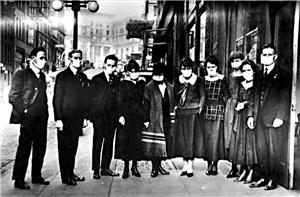On October 3, 1918, the worldwide Spanish influenza epidemic arrives in Seattle, with 700 cases and one death reported at the University of Washington Naval Training Station. Two days later, Seattle Health Commissioner Dr. J. S. McBride states that the disease is "admittedly prevalent." Some 1,600 persons die in Seattle during the next six months despite the closing of theaters and schools, the banning of public gatherings, and the widespread wearing of gauze masks.
No Dancing, No Spitting, No Gathering
Throughout the world, at least 21 million people died from the Spanish flu (so-called because the especially virulent strain of influenza was first noted there, although its actual place of origin remains a mystery), including some 700,000 in the United States.
Influenza, characterized by rapid onset and high fever, arrived in Boston on August 31, 1918, and made its way to Puget Sound the following month on a trainload of sick Navy draftees from Philadelphia. Fatalities result from pulmonary edema (the collection of fluid in the lungs) or from secondary infections from bacterial pneumonia. Persons between the age of 20 and 35 experienced the greatest risk. The massive movements and concentrations of populations during World War I contributed to the rapid spread of the disease. Seattle's population swelled to more than 400,000 because of military facilities and shipbuilding.
At first, Seattle authorities acted by banning dances and ordering street cars and theaters to ventilate to the fullest extent, and police enforced the anti-spitting ordinance. The Old City Hall and the Women's Dormitory (now Clark Hall) at the University of Washington were pressed into service as hospitals to handle the mass of cases. When ministers complained about the ban on religious gatherings, Dr. McBride remarked, "Religion which won't keep for two weeks is not worth having" (Rockafellar, p. 106). All but close relatives were barred from funeral services.
Vaccines and Gauze Masks
Because the disease appeared in Seattle six weeks after it was first seen in Eastern cities, military and civilian officials had at least some chance to prepare. During early September of that year three navy doctors and Dr. B. J. Lloyd, a surgeon with the U.S. Public Health Service, developed a vaccine made from killed cultures of the streptococcus bacteria (the viral cause of influenza would not be discovered until the 1930s). In late September and early October, they vaccinated 4,212 navy personnel dispersed among six camps in Seattle and Bremerton, all men.
Even to those operating under the mistaken assumption that influenza was a bacterial disease, the results were difficult to interpret. A higher percentage of those vaccinated (more than 22.6 percent) came down with the flu than those who were not vaccinated (16.6 percent). To further muddle matters, there were wildly different outcomes in the different camps.
There was, however, one optimistic finding. Not a single man from the vaccinated group died, but 96 of the unvaccinated did. This was no doubt due to the vaccine preventing (or at least weakening) secondary bacterial infections, as it could not have affected the flu virus in any manner. Nonetheless, the four doctors, in a report published in the Journal of the American Medical Association on January 4, 1919, claimed success: "We believe that the use of killed cultures as described prevented the development of the disease in many of our personnel and modified its course favorably in others" ("Influenza As Seen ... ," p. 28). They were at best half right.
According to press reports, in Seattle more than 175,000 people were vaccinated, but exactly what they were given is not clear. And, unlike the experiment with military personnel, there seems to have been no systematic attempt to judge the efficacy of the vaccine.
On October 29, 1918, six-ply gauze masks became mandatory in Seattle. The next day they were required throughout the state. But public health discipline fell apart when the Armistice was announced on November 11, 1918. Thousands of joyous people celebrated in Seattle's streets, but "not a mask in sight." The mask rule was lifted the next day and theaters and public places reopened. Illness and deaths climbed again and peaked on December 9, 1918, before dropping off. Schools were reopened in January 1919 and in March 1919 no deaths from influenza were reported. Seattle suffered a death rate from the disease approximately half that of San Francisco and a third that of Philadelphia and Baltimore.
The disease disappeared from around the world almost as fast as it appeared and it has not reappeared since.

